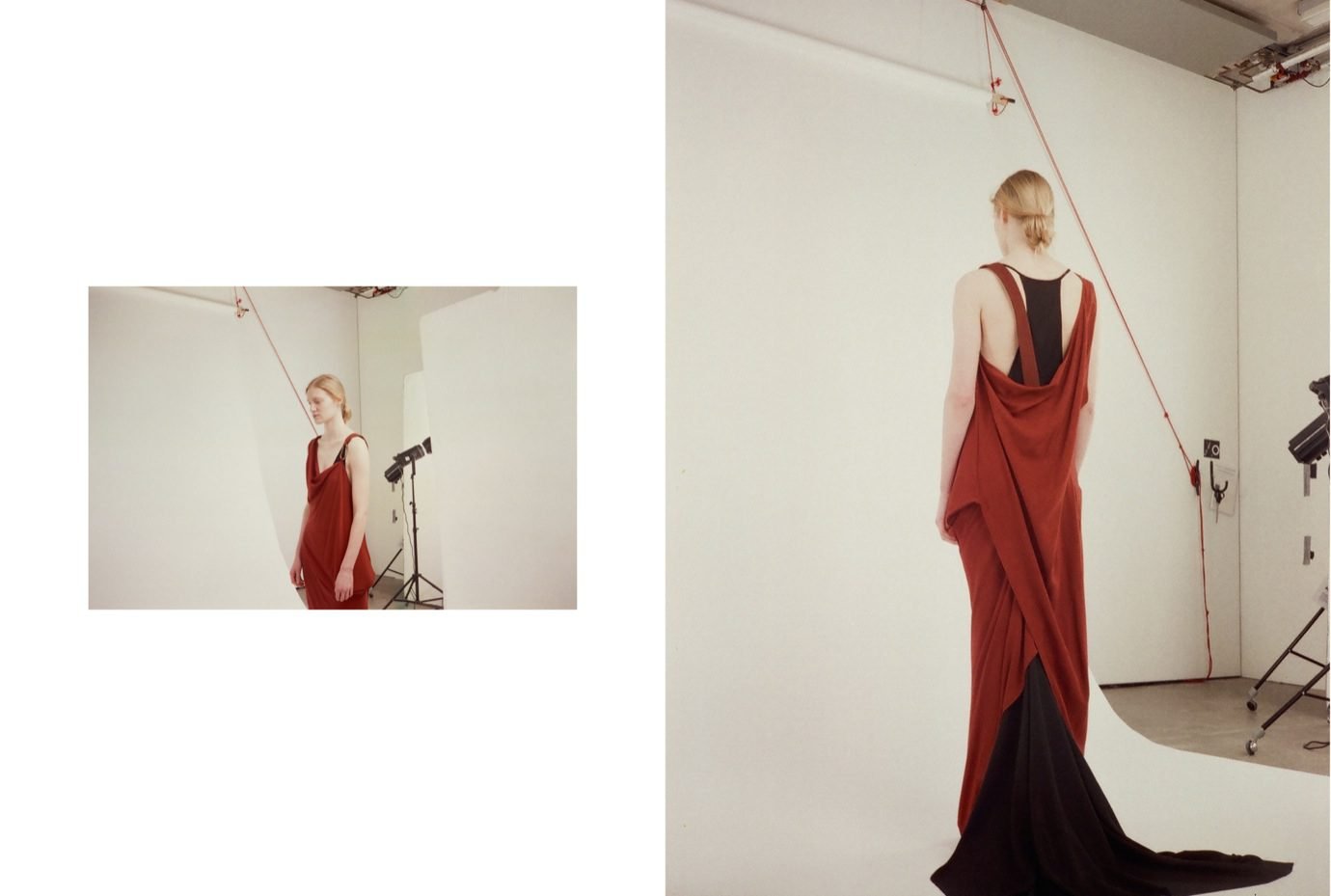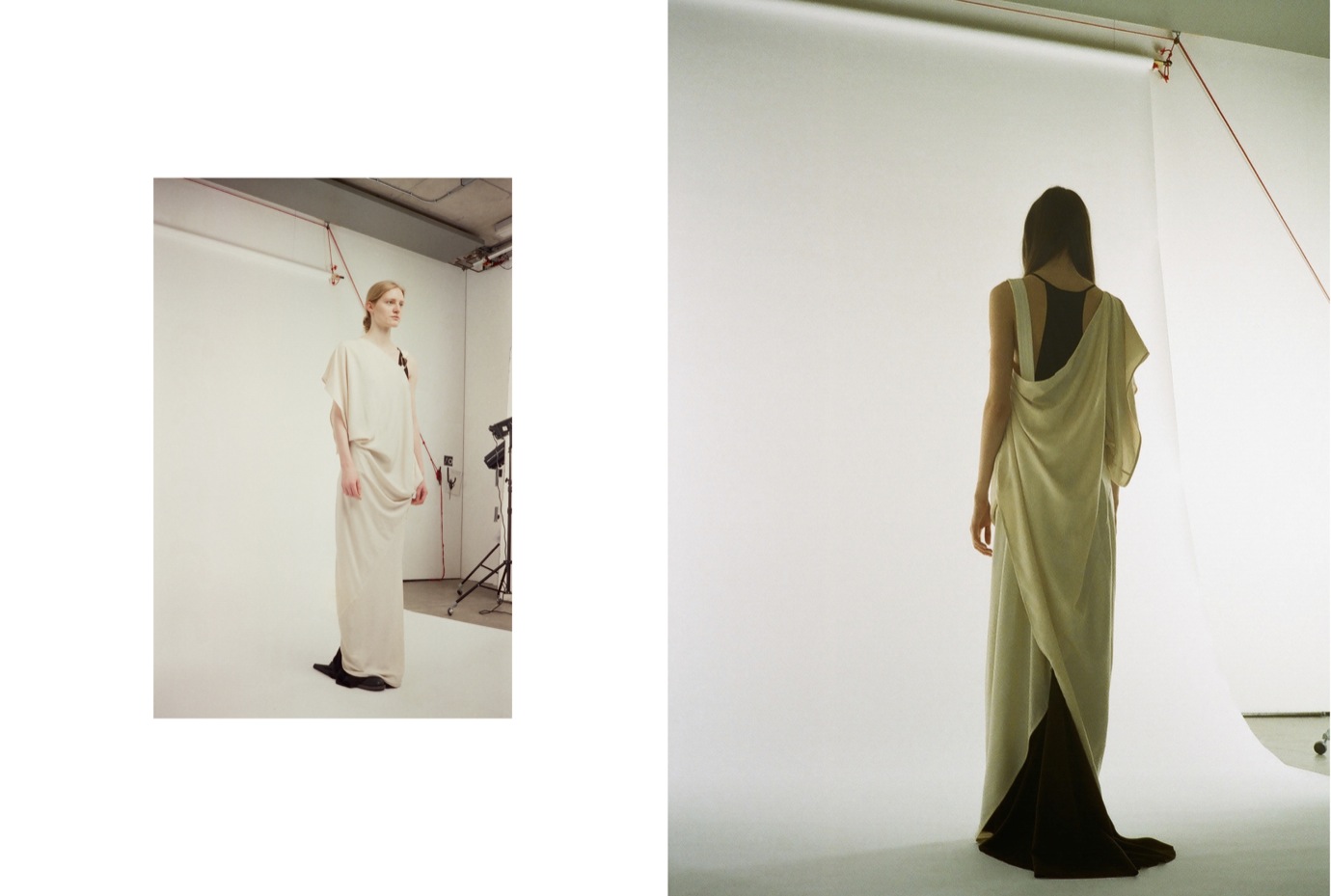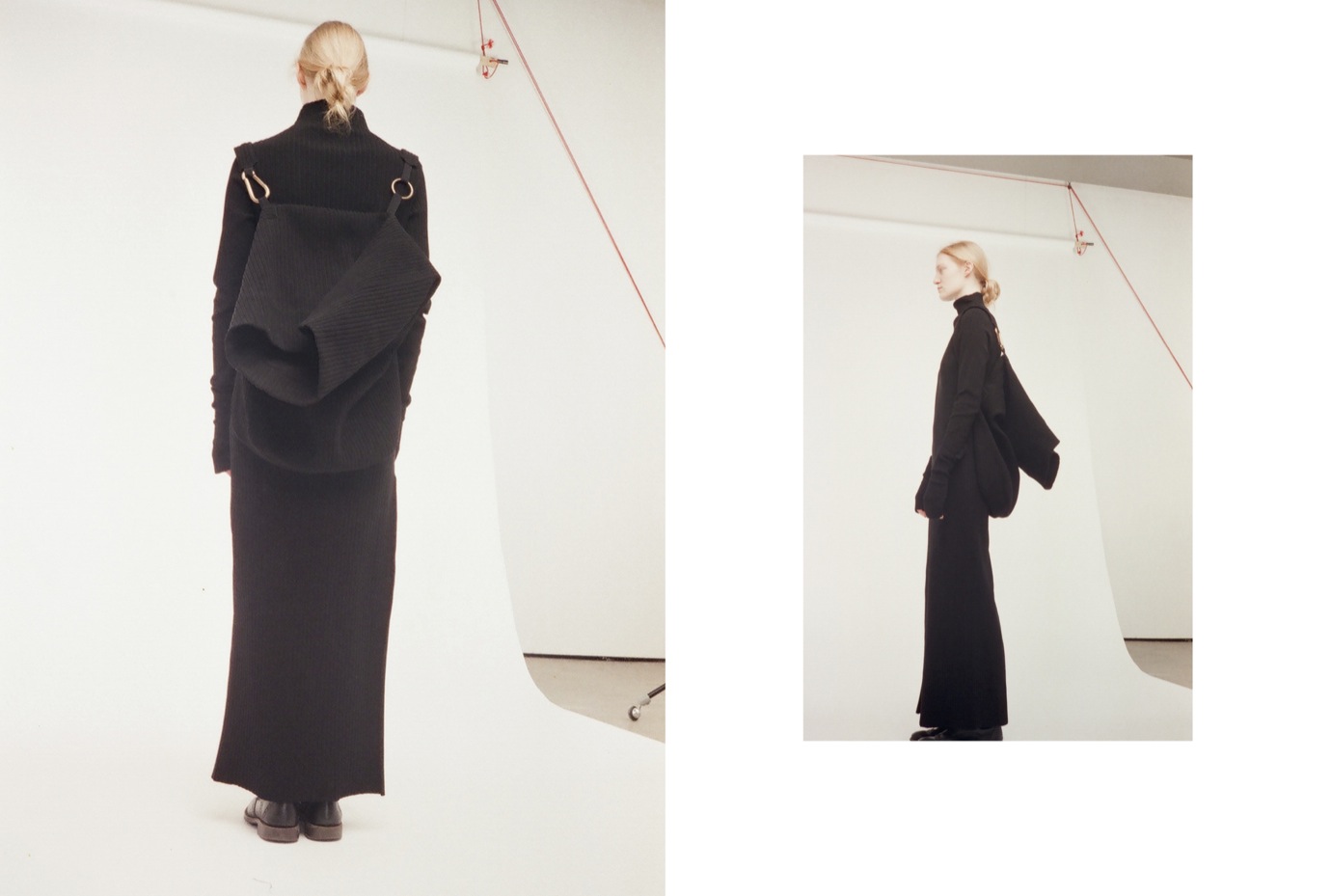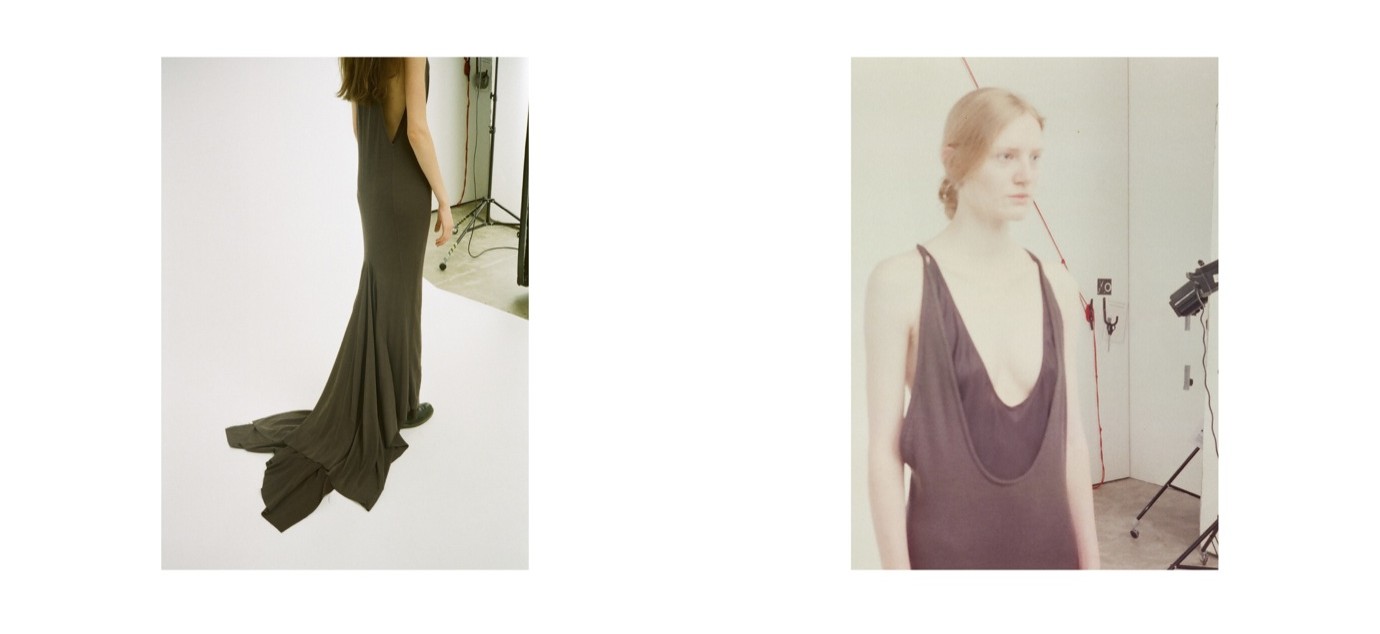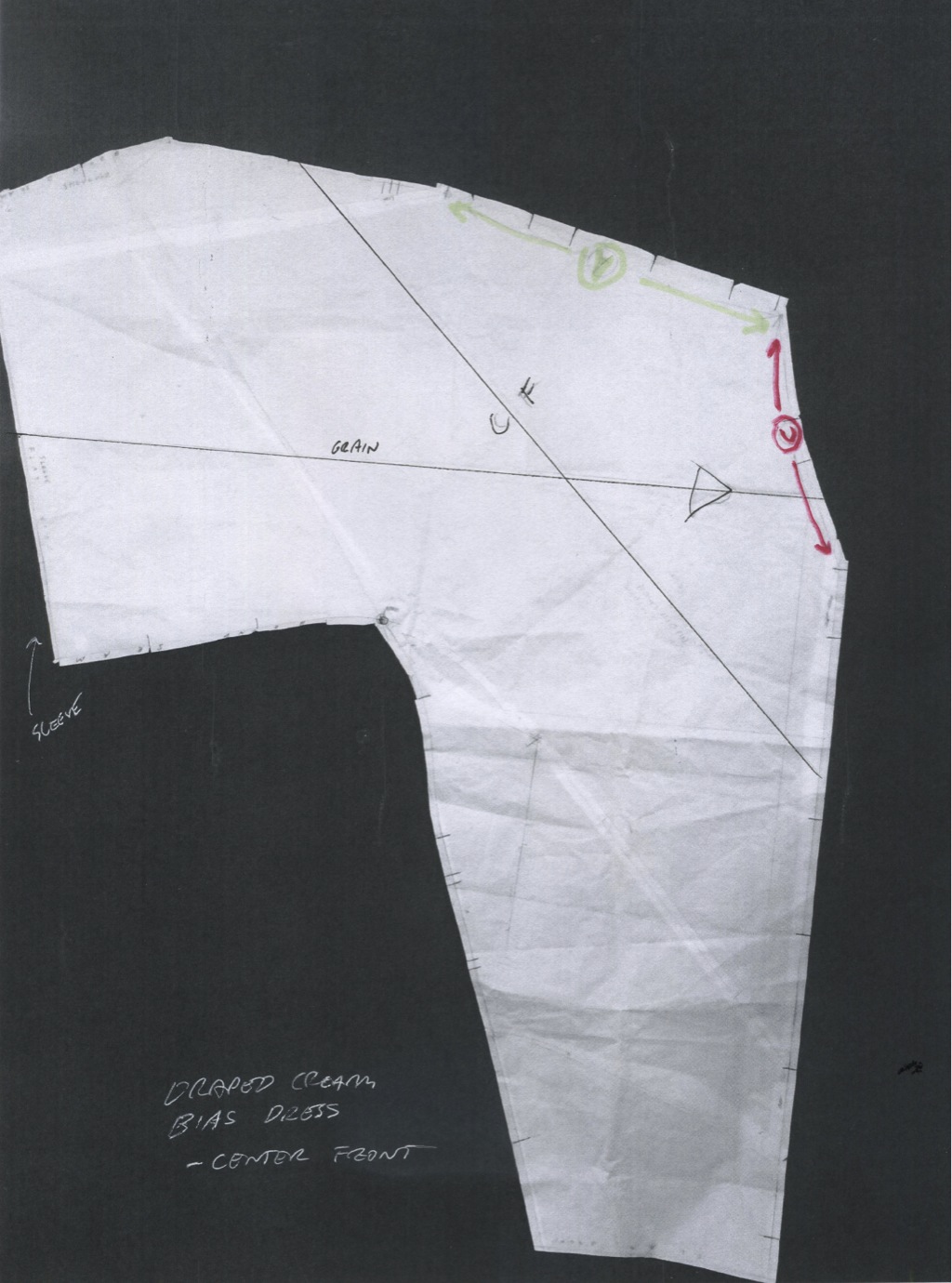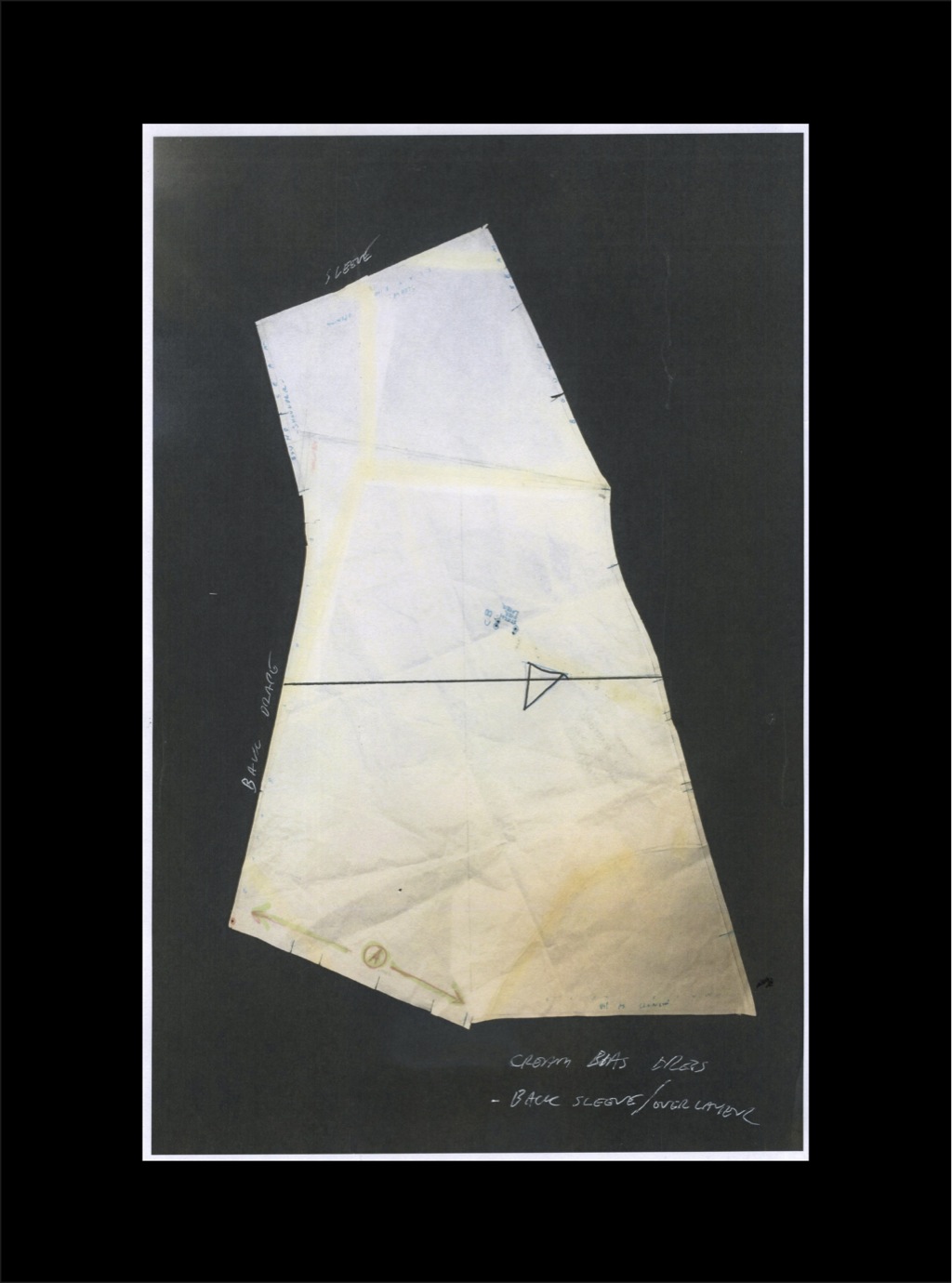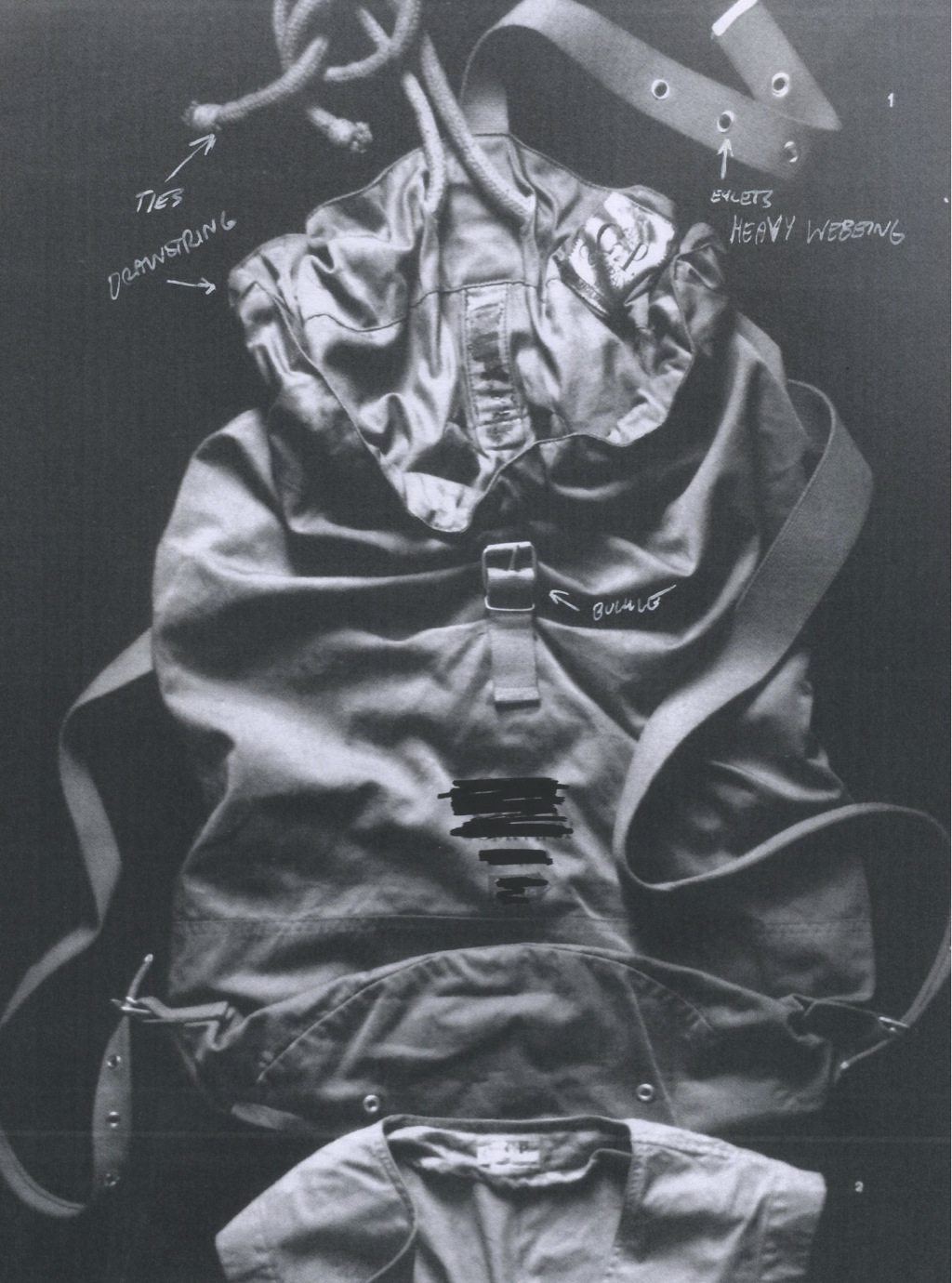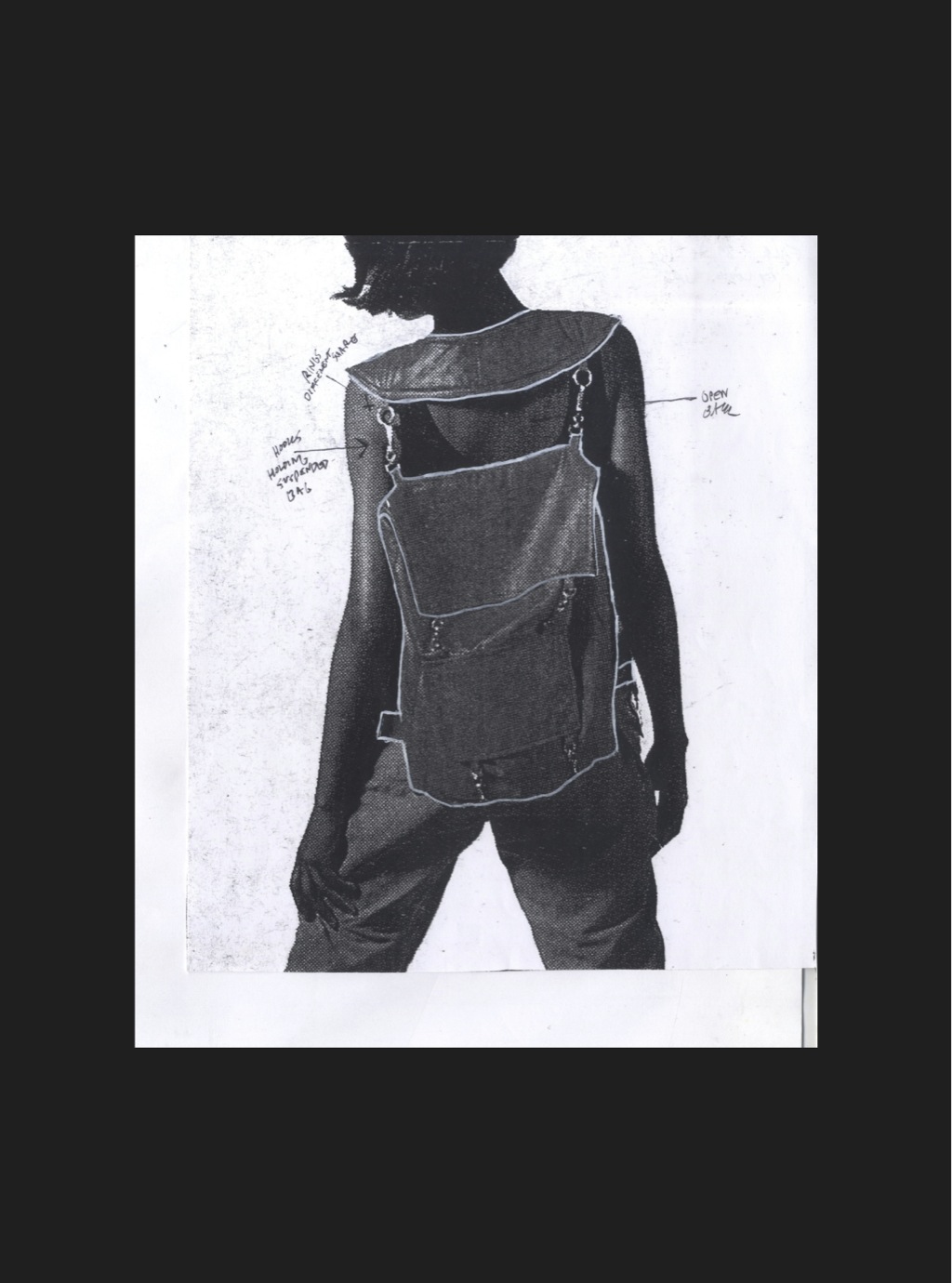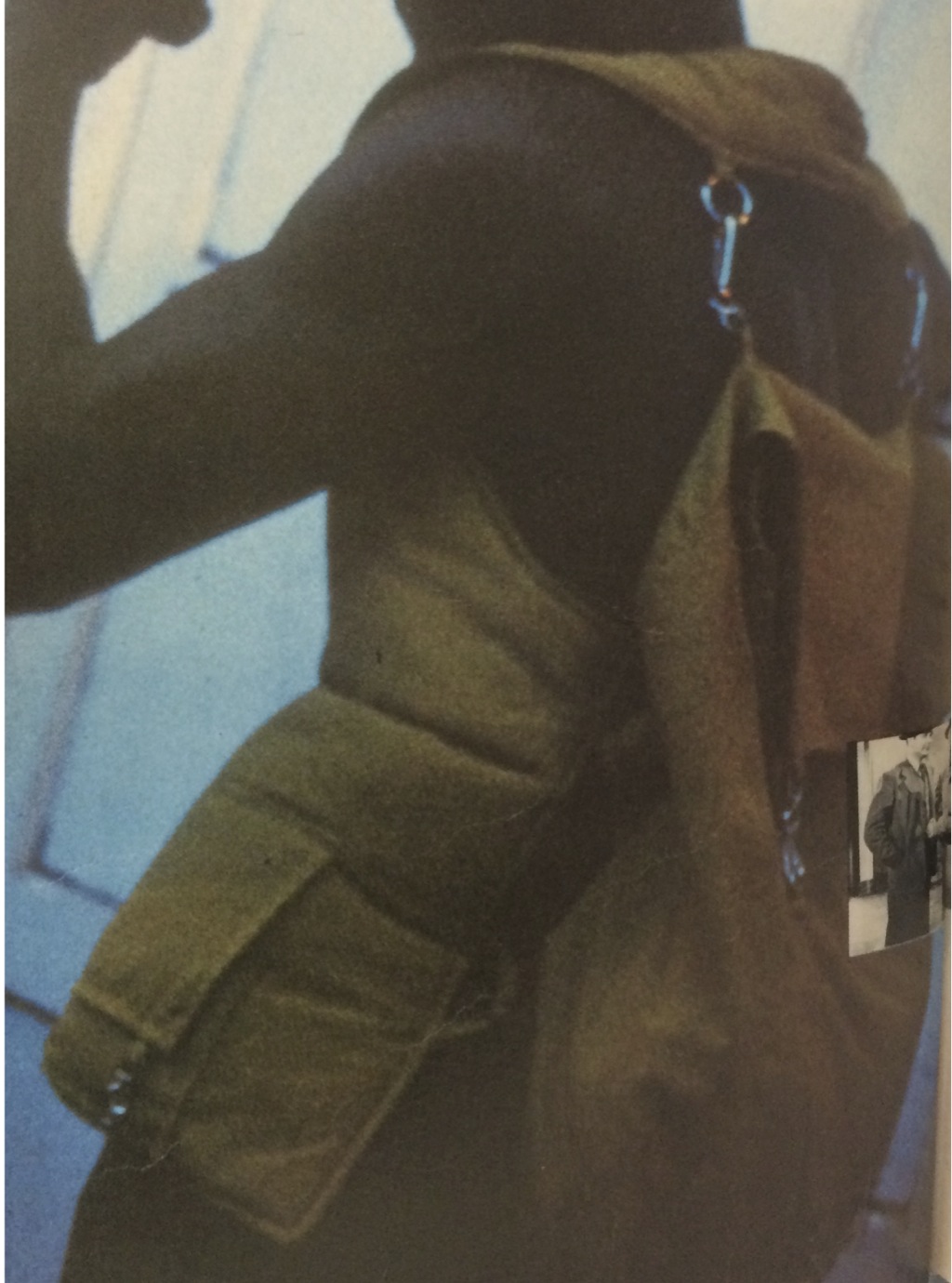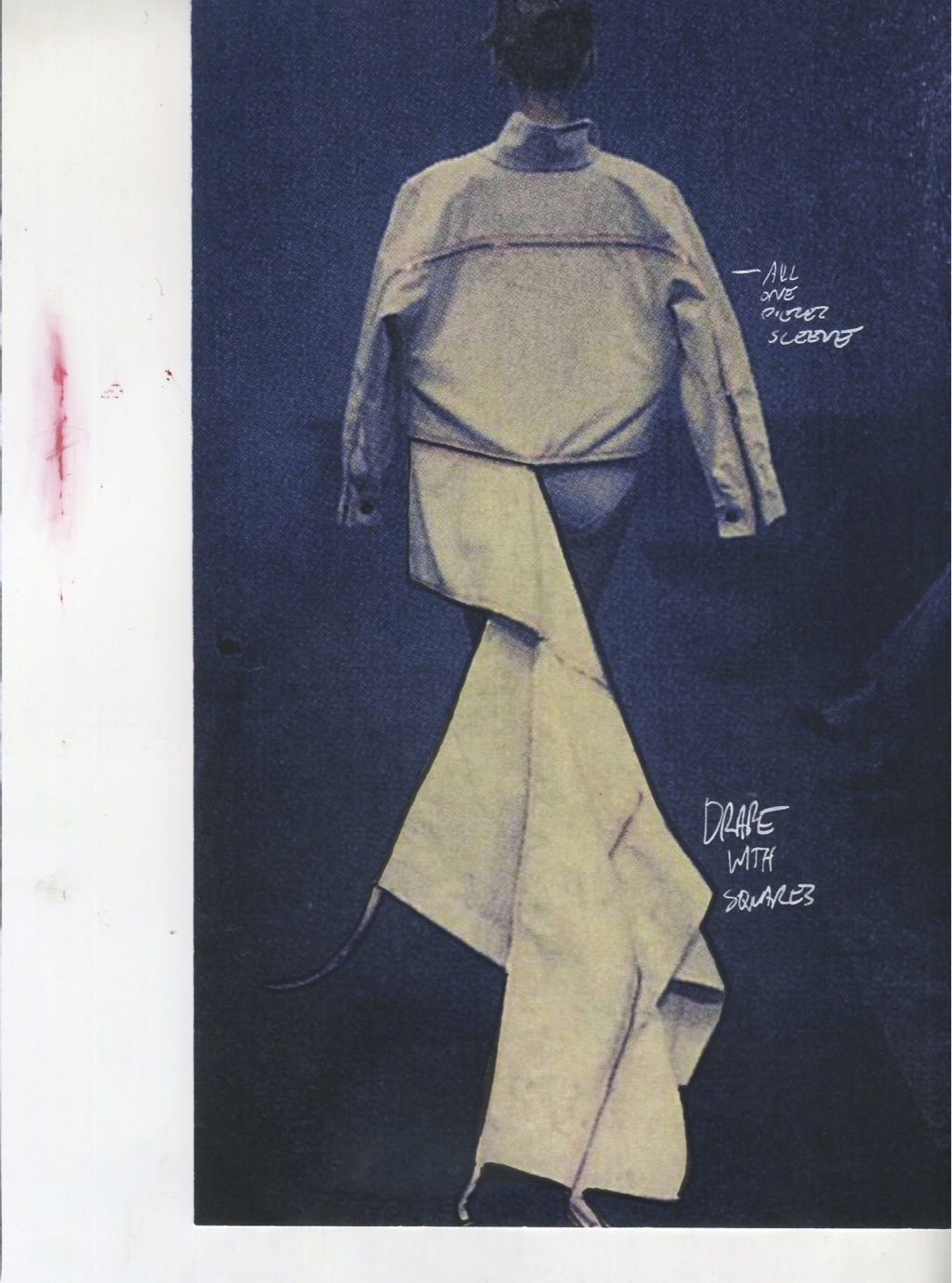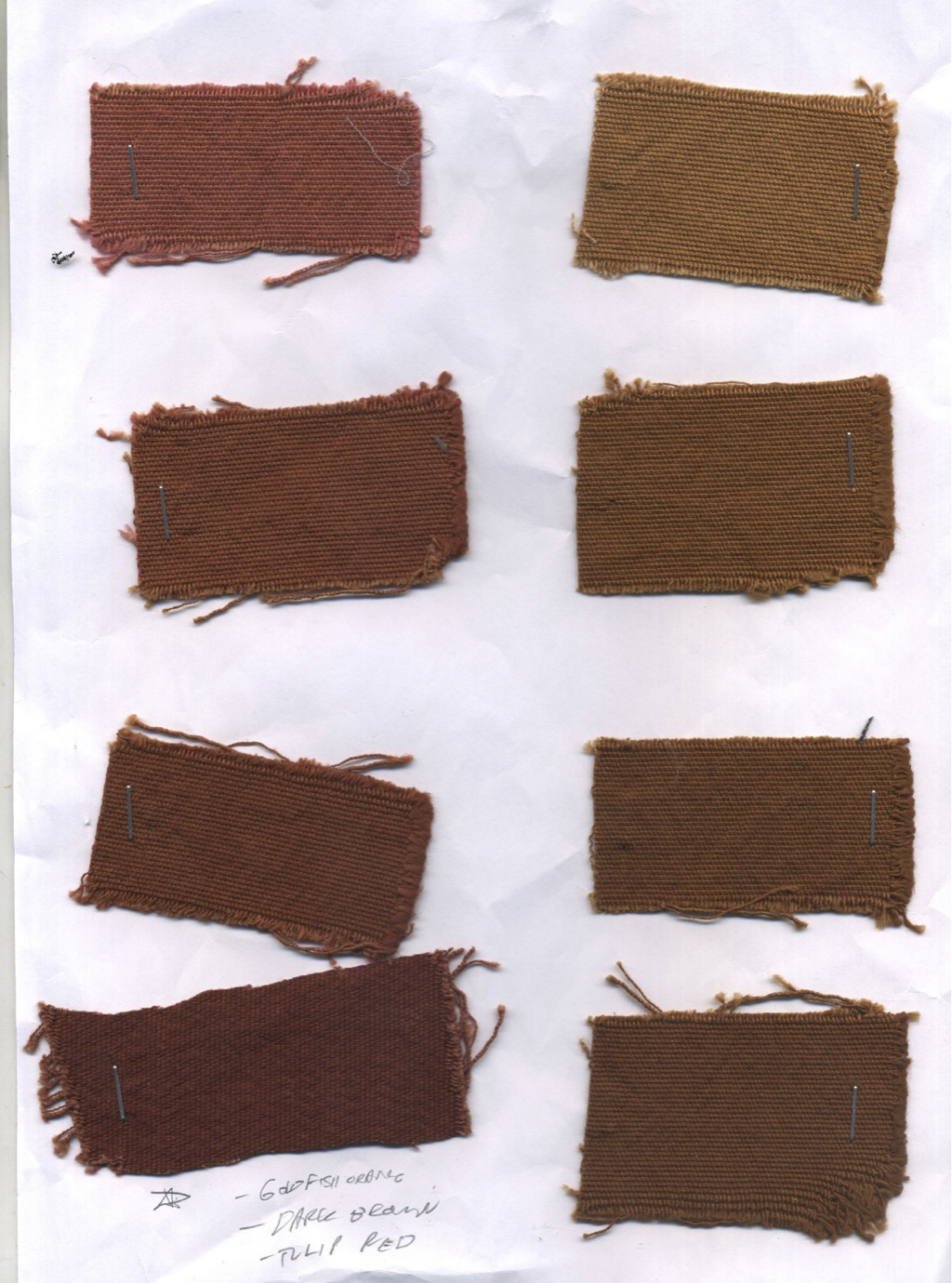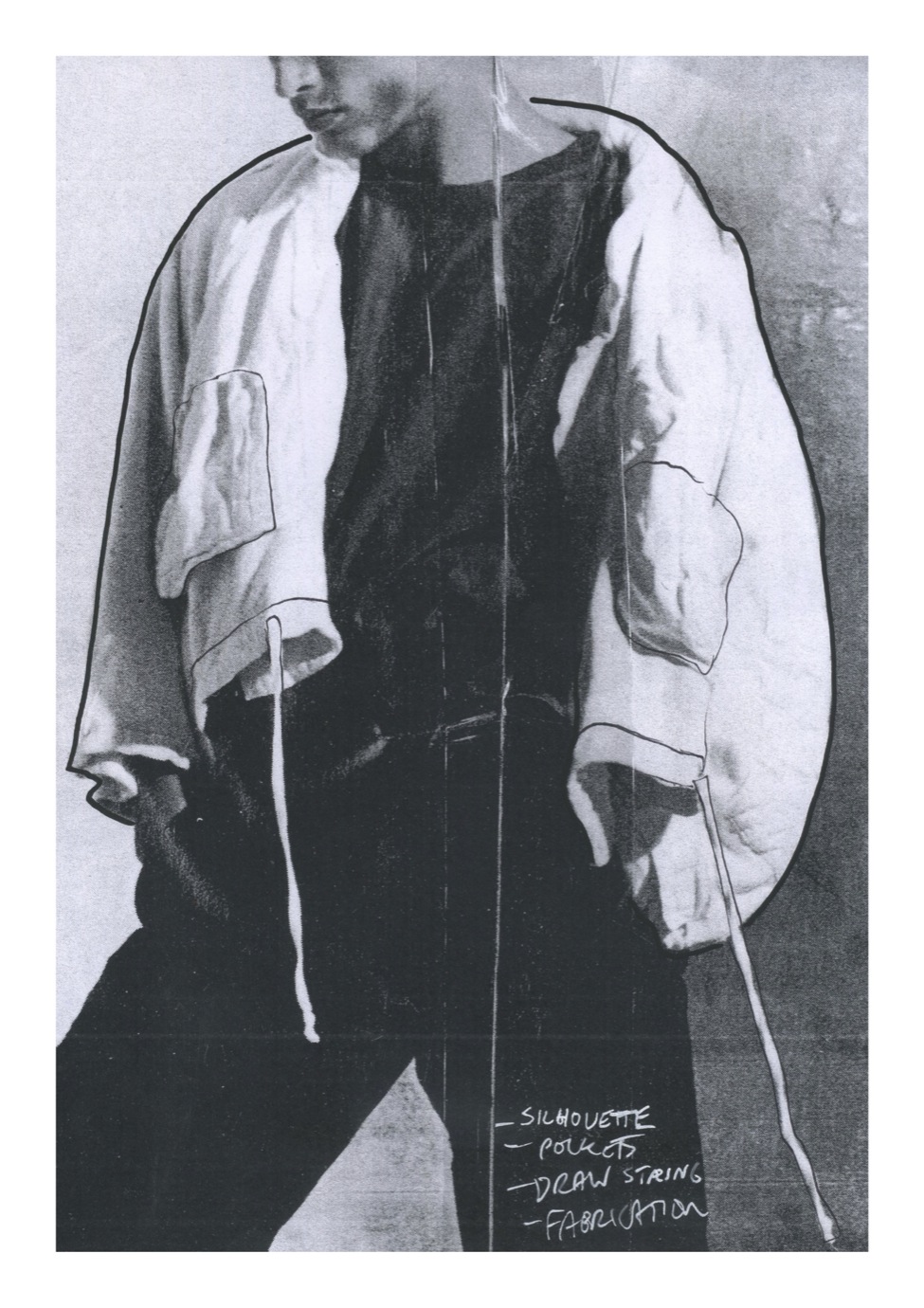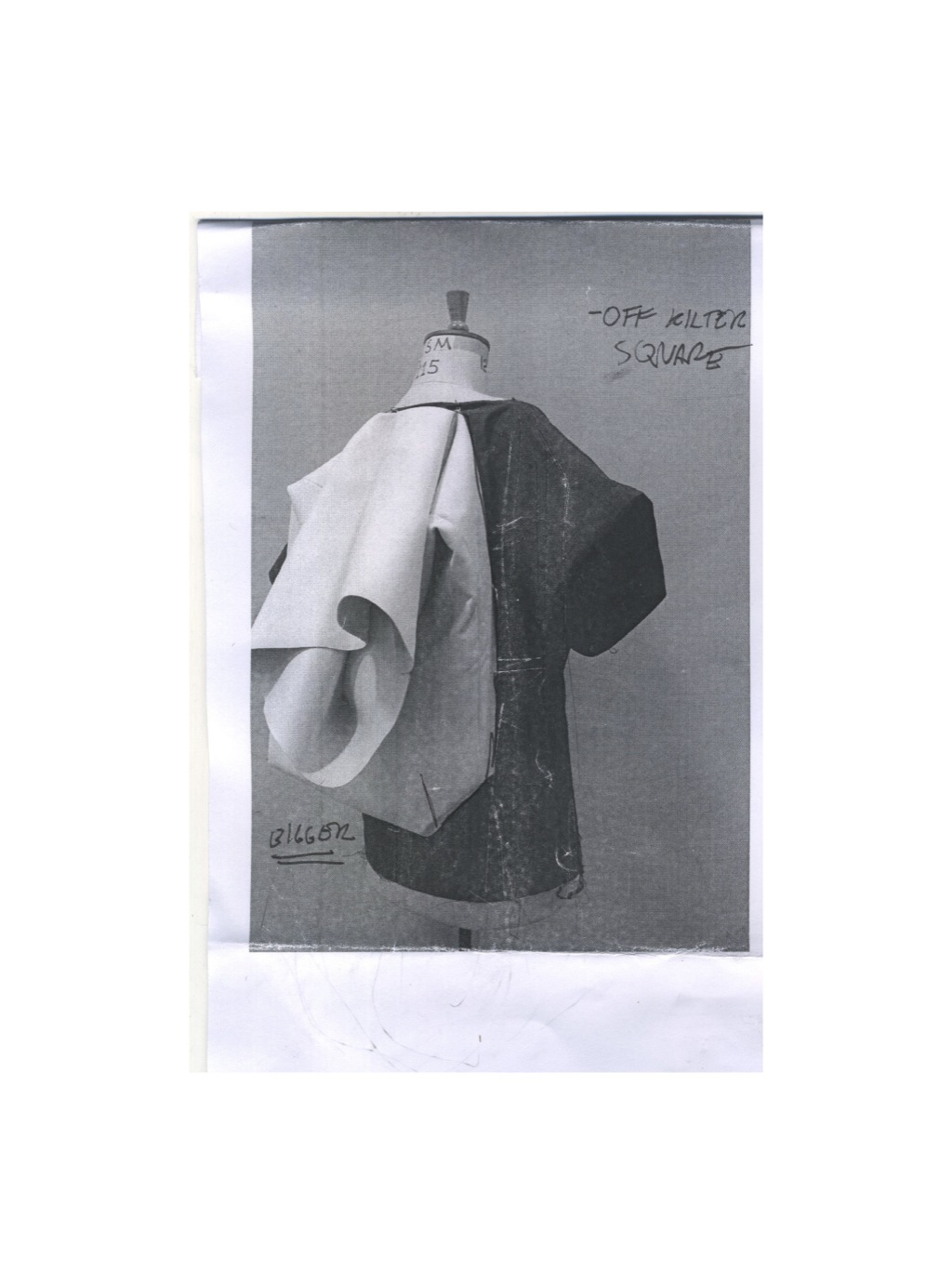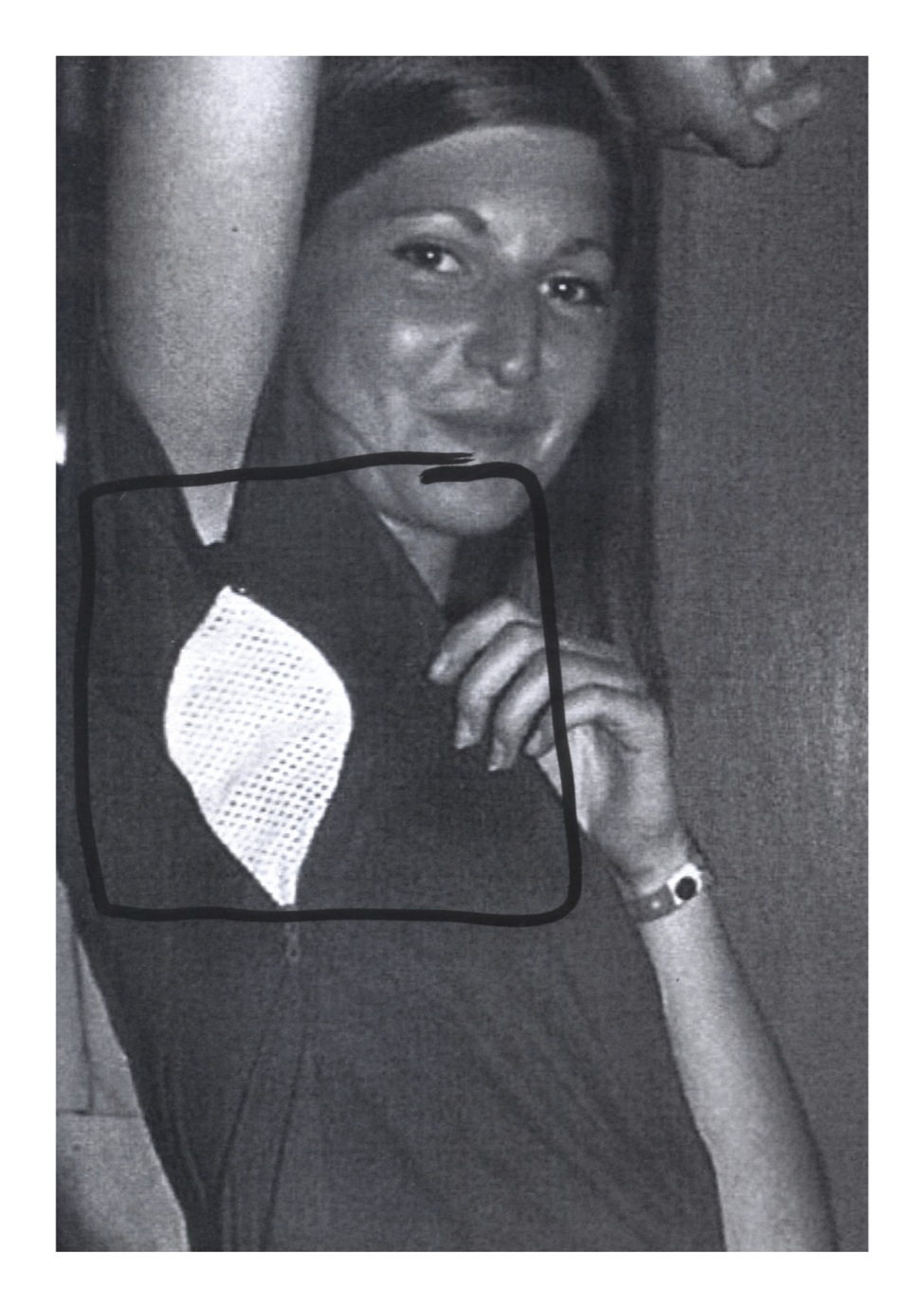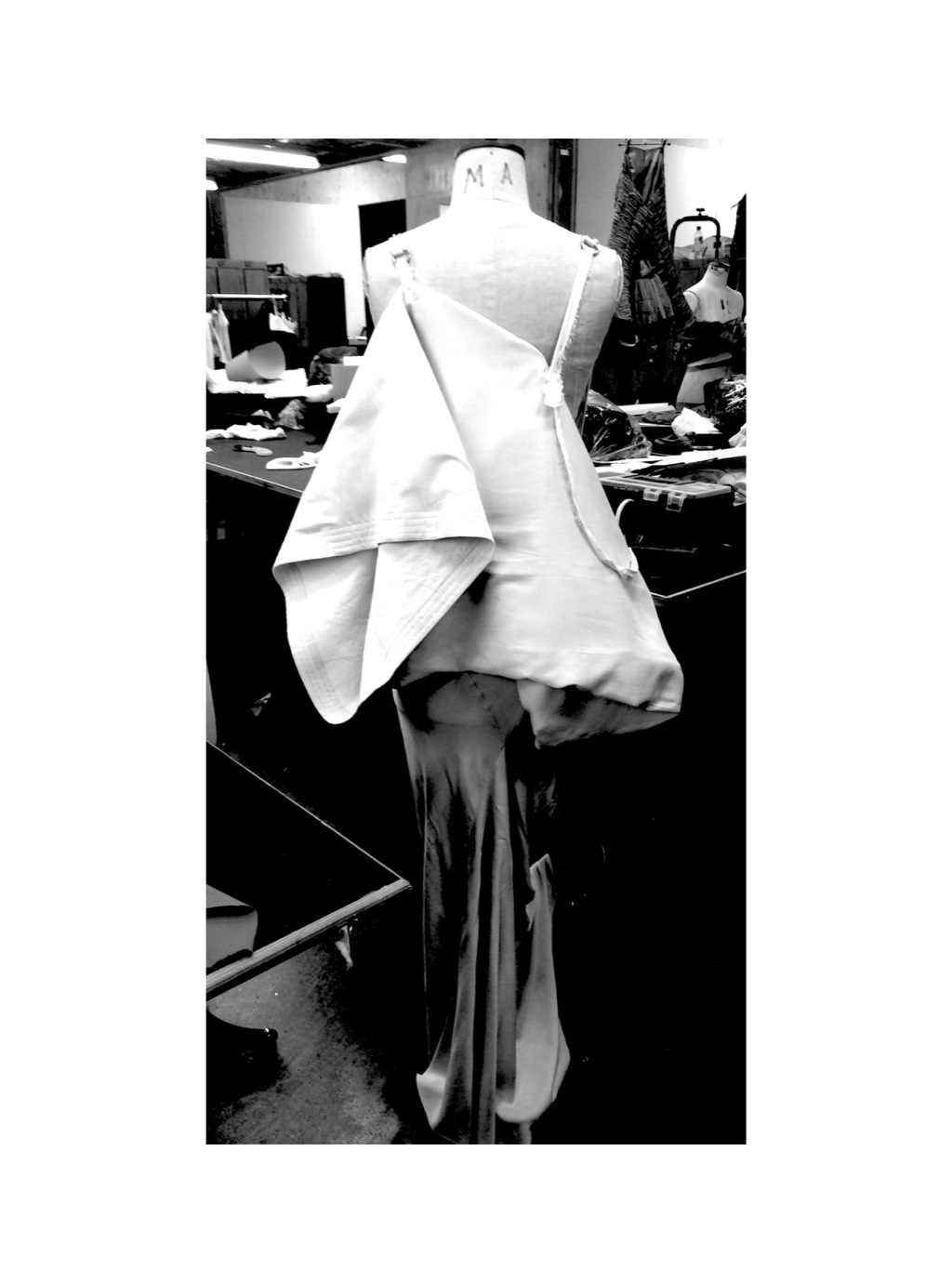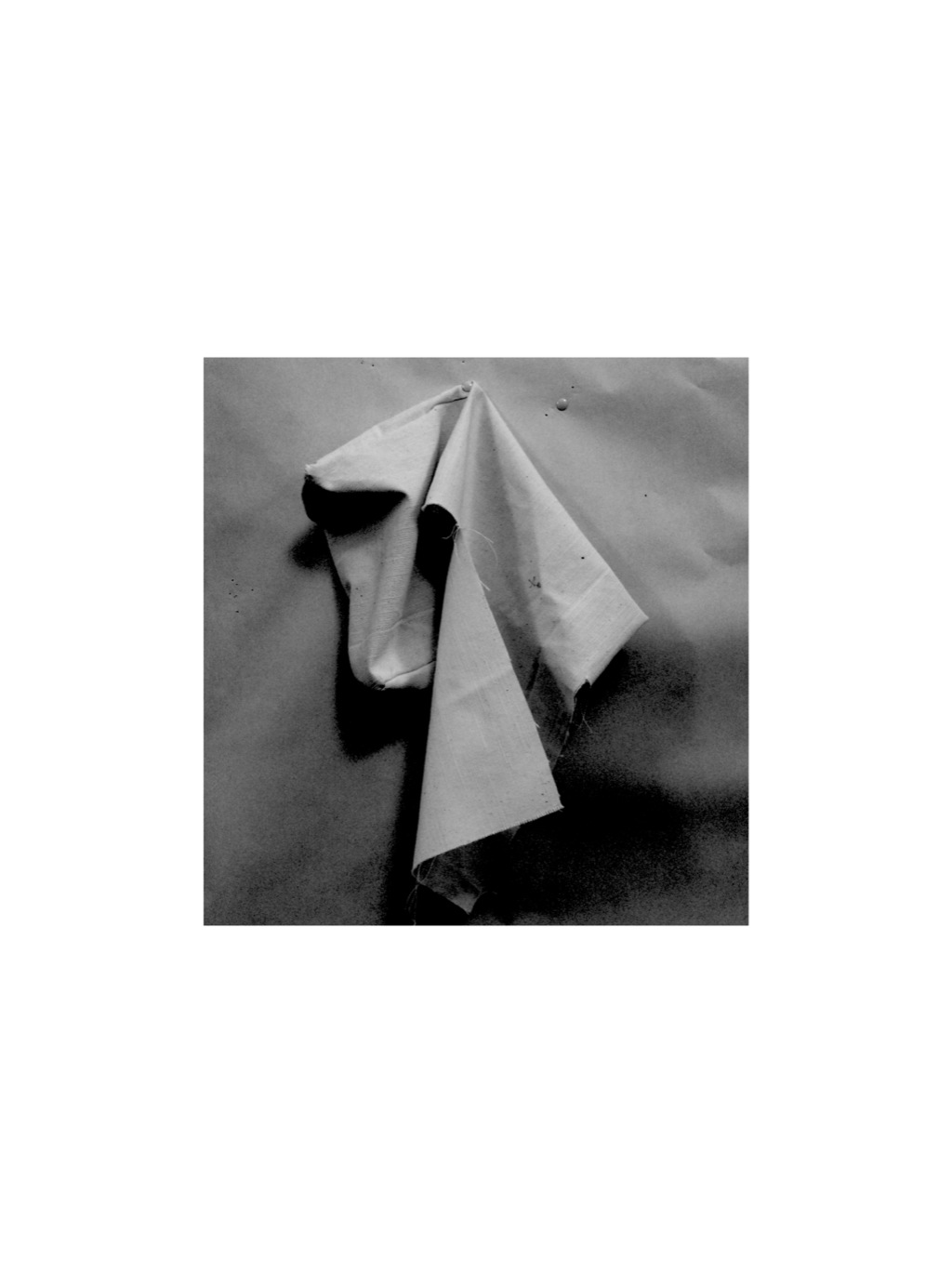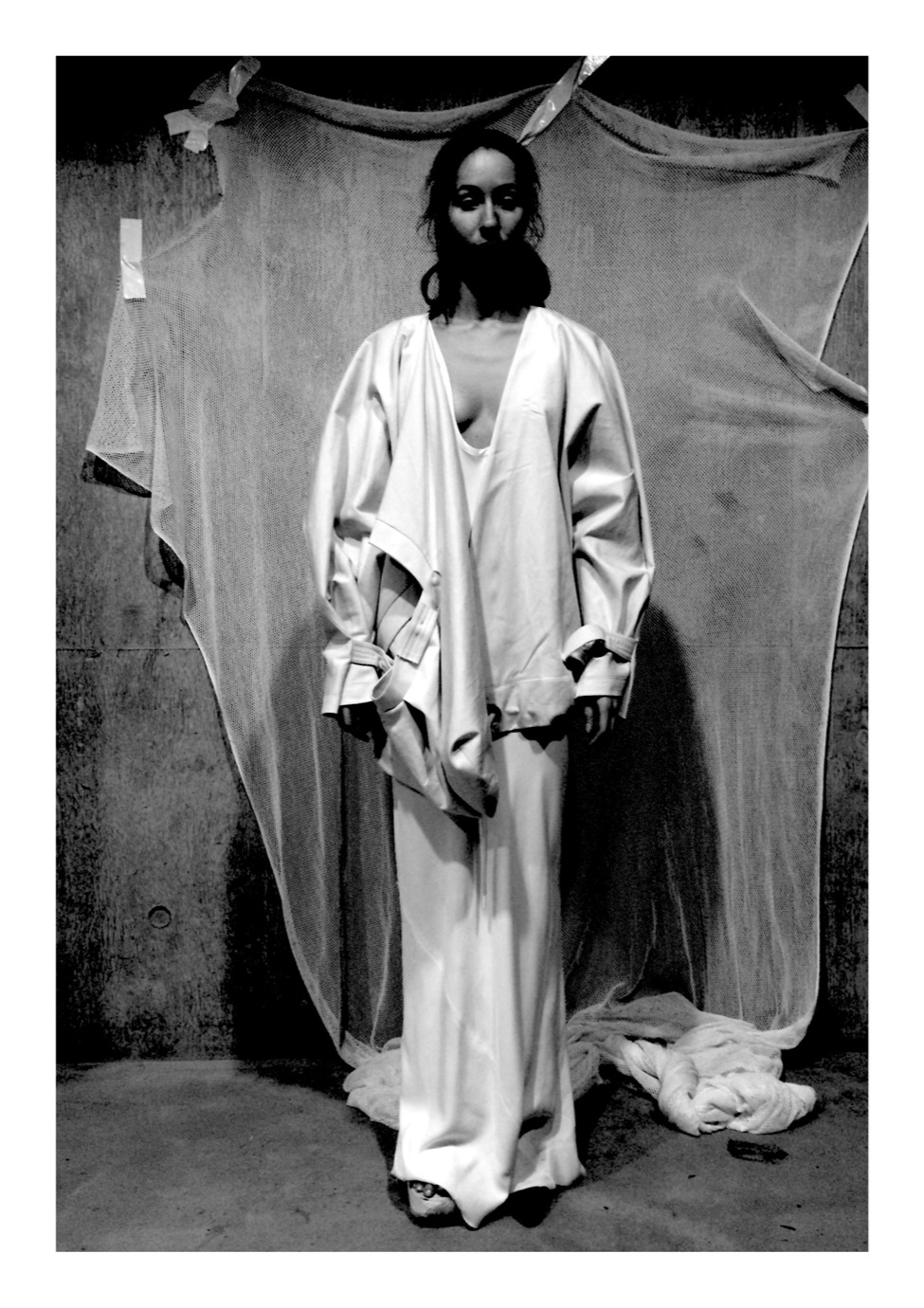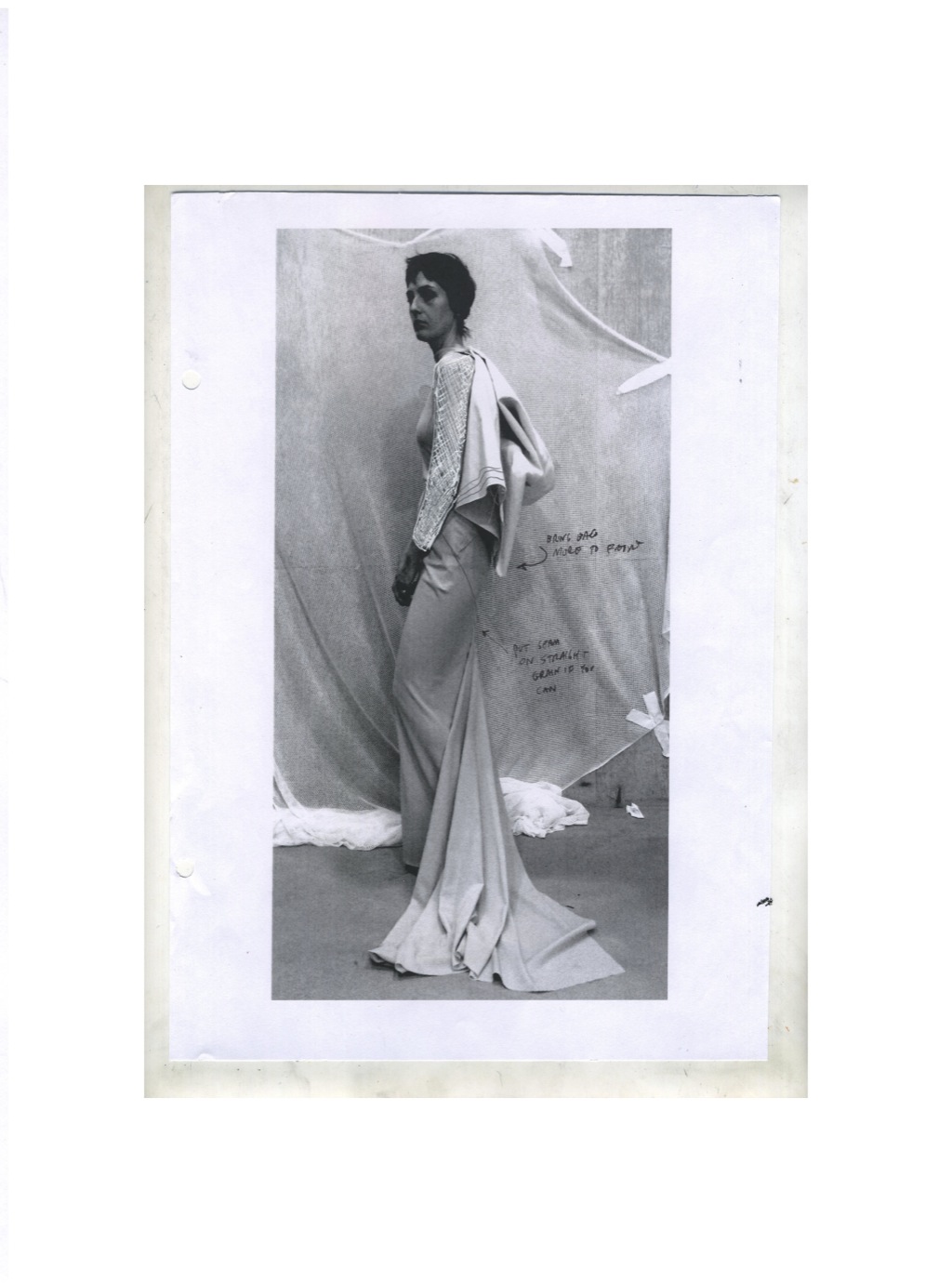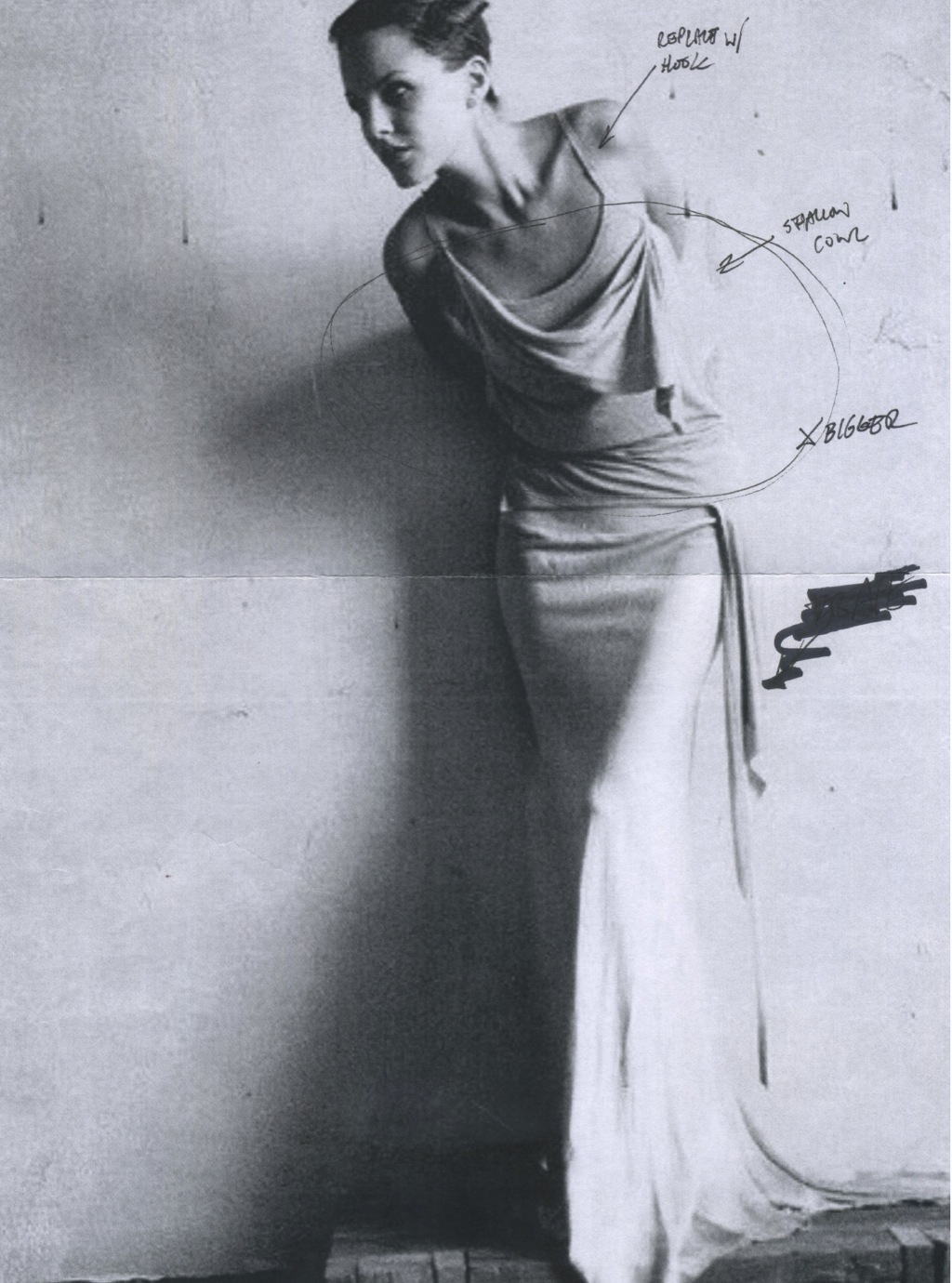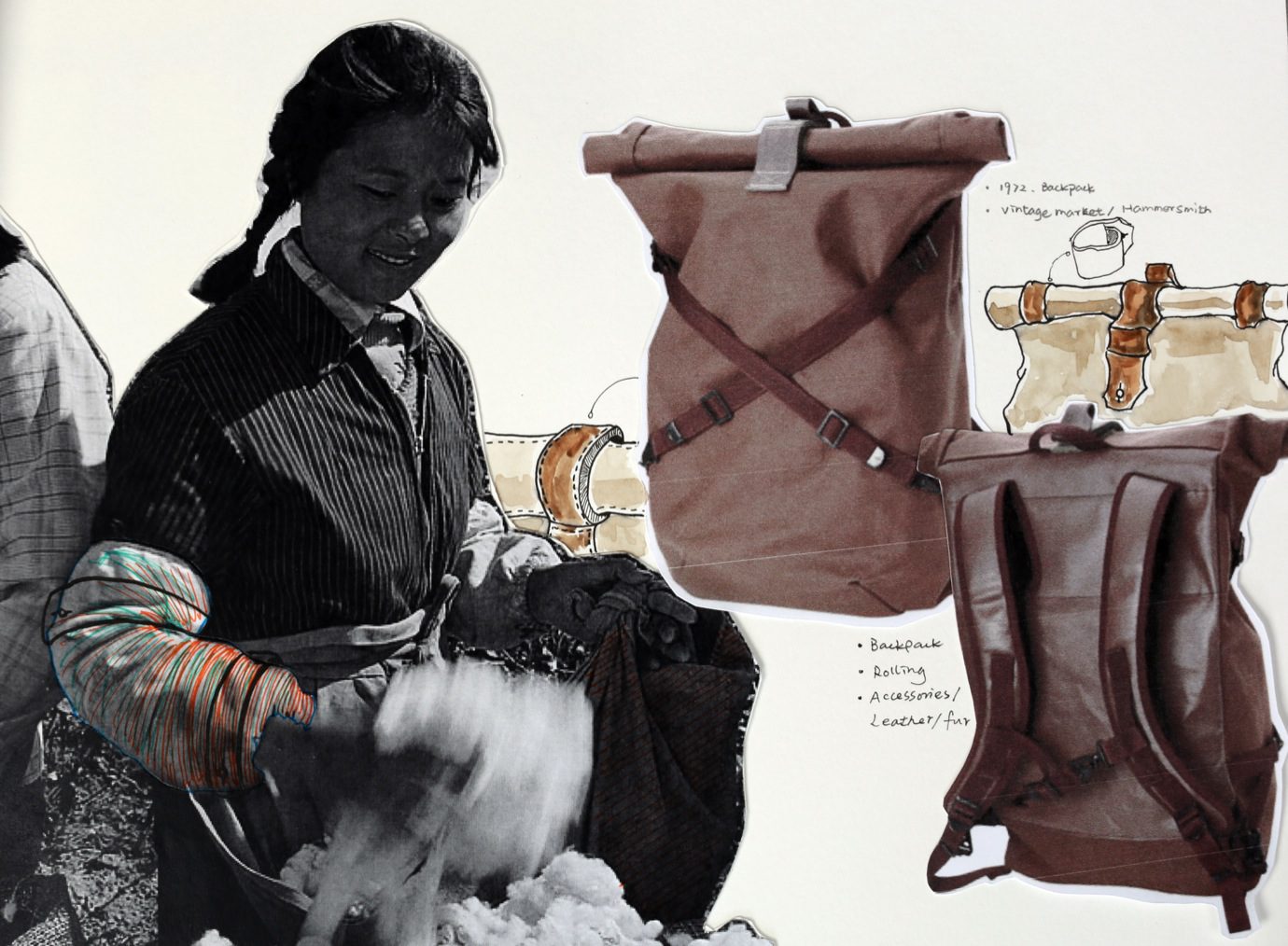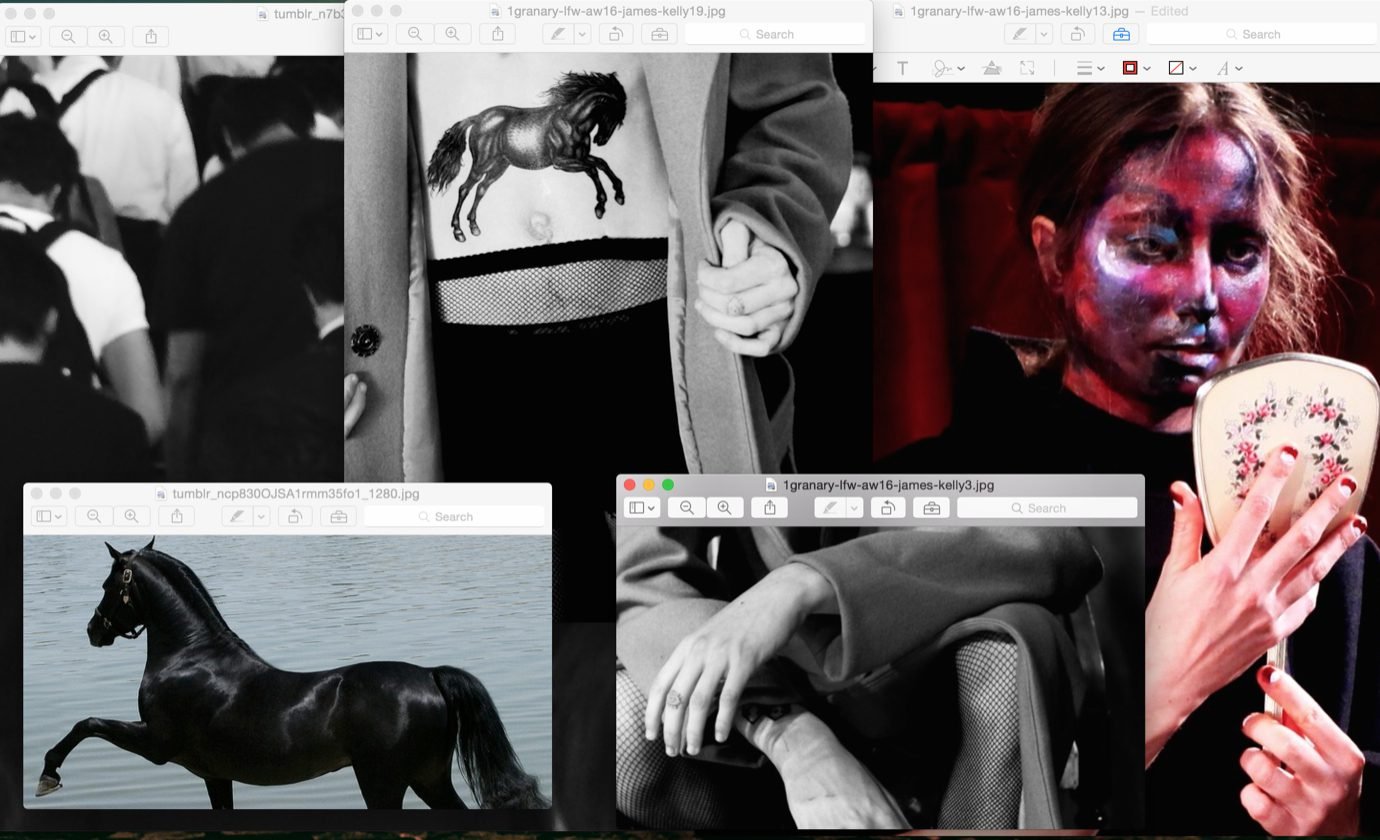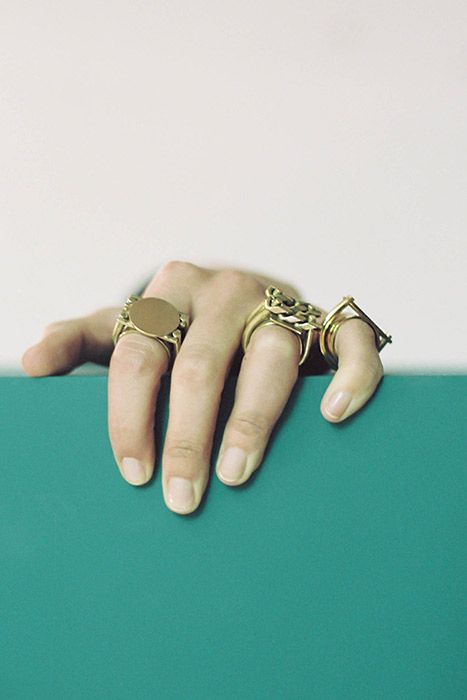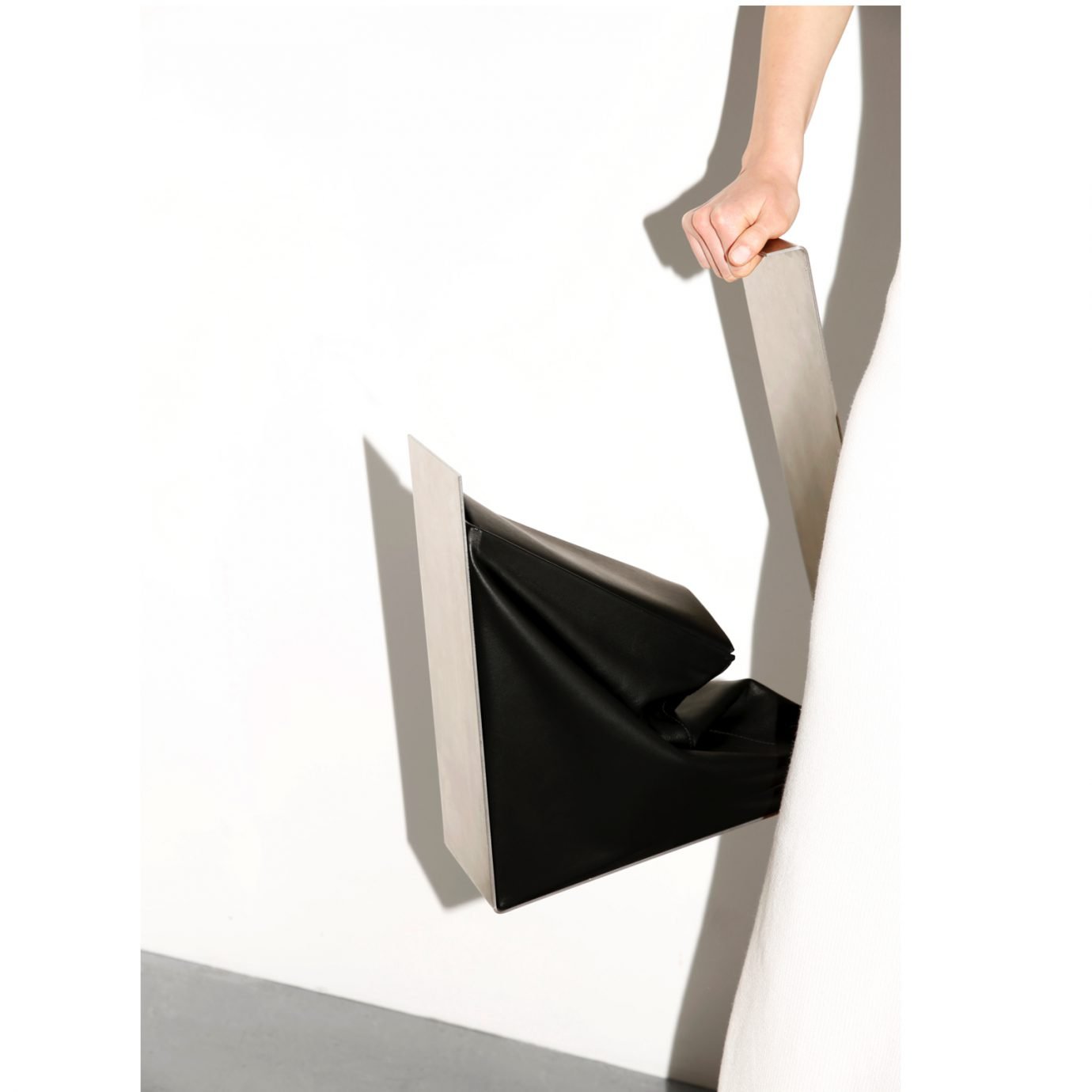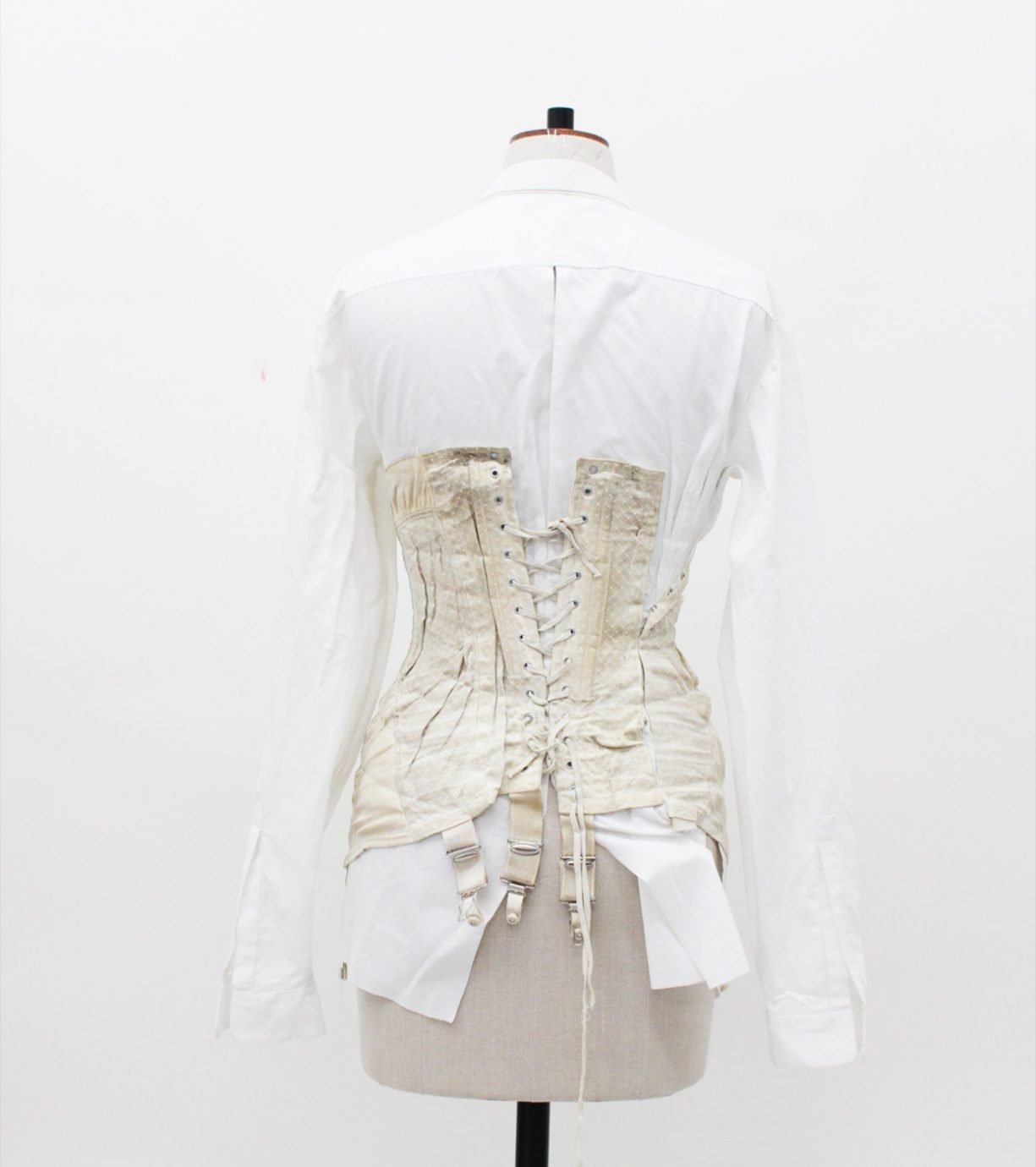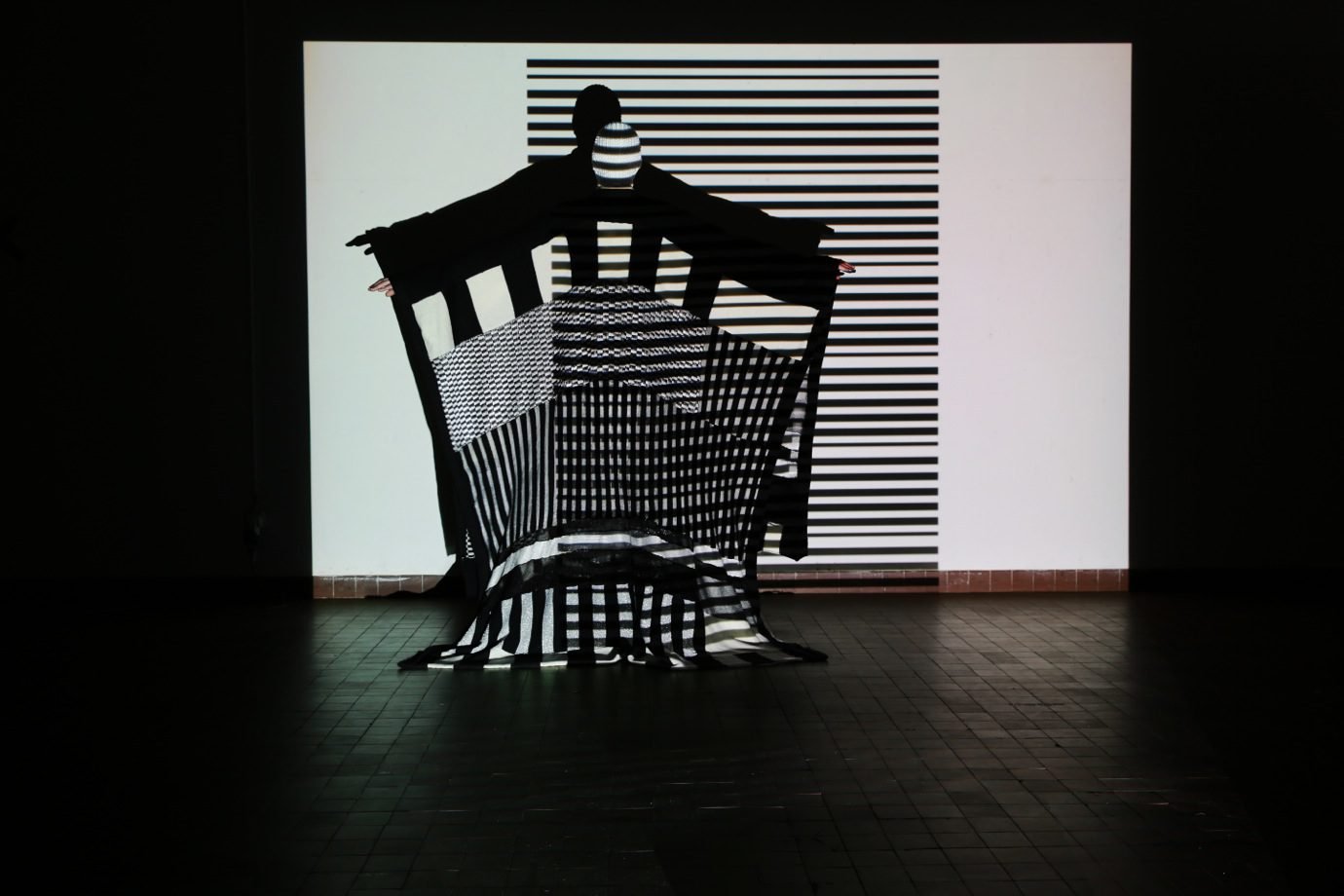Following his graduation from Brown University (where he studied Visual Arts and History) and upon completion of a pattern-cutting course at RISD (Rhode Island School of Design) that he did during his BA, Snyder, 25, undertook an internship at the American couturier Ralph Rucci. Given his affinity for bias-cut dresses, Austin knew that he could learn a great deal of technical skills from the team, so that became the plan in motion. But it wasn’t always like that. There was an initial sense of resistance: “for a while, I thought that gowns were stupid, but now I can’t fight it. They’re fascinating objects: putting them together, patterning them, making sure that the grain is in the right place so it sews nicely, is a cool challenge.” He attributes this sense of competitiveness to being an ex-distance runner. “I want to be the best at whatever I’m doing, so I want to go to the best places,” he goes on to say, thus explaining why he decided to apply to CSM. Within just a short month of being with the New York-based brand, Snyder was hired into a permanent position. “I loved evening dresses but the high-end, super strict, old-school world of couture just wasn’t for me. I wanted it to be more relaxed, but I learned a lot about the technicalities of it all, so this year I wanted to give into that and make a bunch of dresses,” he recalls. There’s a sense that finally, something has been lifted and he’s no longer resistant to his gut instincts.
The Masters: Austin St. Maur Snyder
Backpacks merged with gowns. Gowns inspired by backpacks. However the sentence is phrased, you are certain of one thing: it’s an unlikely pairing. In a world so obsessed with binaries, the grey area becomes increasingly alluring. And that’s what we have here: the meeting point between formal and casual in a collection of reimagined evening dresses. The story of this unexpected merging stems from the neo-nomadic life of Austin St. Maur Snyder, who has spent the past six years moving between his home of California and then Rhode Island, New York and London for education and work. As a diehard Californian residing in Finsbury Park, Snyder’s own personal binary is near and far. Constantly looking back to the places he has come from; constantly looking forward to the places he’s going – it’s a relentless process. Through all of it Snyder has had a black canvas backpack on his shoulders; something he describes feeling naked without. There’s even a picture of a Monisola Omatoso ‘Jack-sac’ on his bedroom wall, next to another of an early Rick Owens gown. There you have it: two photos of his single most seminal inspirations that he wakes up to every single morning. Attracted to the beauty of bias-cut gowns but plagued by the question of where he’s moving next, Snyder makes a collection that manifests the fibre of his life, his friends and many different homes all into a world of subdued sensibility.
“FOR A WHILE, I THOUGHT THAT GOWNS WERE STUPID, BUT NOW I CAN’T FIGHT IT. THEY’RE FASCINATING OBJECTS: PUTTING THEM TOGETHER, PATTERNING THEM, MAKING SURE THAT ALL THE GRAIN IS IN THE RIGHT PLACE SO IT SEWS NICELY IS A COOL CHALLENGE. BUT I LIKE A CHALLENGE AND I LIKE TO WORK FOR IT.”
Austin has what he describes as a “throw-everything-in-a-blender mentality,” when it comes to his inspirations. We know that he loves a particularly sleek kind of dress, but within that, he’s always gravitated towards the minimal and relaxed designs of early Calvin Klein, Ann Demeulemeester and Donna Karen (as well as Rick Owens). On Owens, Snyder explains, “he’s from California you know? It really shows, I love how his older work transported you into his relaxed and glamorous world just by looking at it.” There’s a sense of throwback pride not only from what Austin explains about his inspirations, but how he says it: “Everything was better in the 90s.” So it makes sense then that one of the problems Austin experienced during the course was, “breaking away from the whole ‘my work is inspired by this artist and this idea’s concept.” For Snyder, the inspiration resides within these garments and gowns themselves, many of which were from the 90s. He feels that “it gets a bit too flowery and cloudy – it’s been most successful when the inspiration has been looking at clothing and not just tulips,” he says, gesturing to the vase of flowers on the table in front of us.
It seems justified then, that California forges its rightful place into the collection. From the offset, Snyder explains that ‘Desert Reality’ by photographer Ed Freeman, became an integral accent within the collection. Freeman embellishes upon his own photos of Californian landscapes, retouching them to somehow heighten the west coast flavour, then serving them alongside the original for comparison. You can see Freeman’s influence: the muddy-hued landscape translates into the coal black of the gowns, the corrugated iron becomes the ribbing in his knitwear and the rusted metal transforms into the terracotta canvas anorak. While Austin is thousands of miles of ocean and land away from these familiar settings recreated by Freeman, he gives it a purpose in the collection, bridging the void between near and far. In doing so, he can simultaneously look to the past while looking to the future. Yet again: exploring the grey area between the binary.
It’s not just the physical space that inspires him, but also the people he left behind. In equal importance to California is Amanda, his best friend from back home. “We’ve known each other for 10 years. I’ve been in love with her since the day I met her. She’s one of the most beautiful people on the planet, brilliant at what she does and looks fantastic all the time. She’s chill. She’s the realest girl ever.” Amanda is not only Snyder’s muse, but she is the girl he aspires to dress. Her personality manifests in the off-kilter styling of these gowns, describing how she’d pair an evening dress with combat boots. The reference is always, “that’s how Amanda would do it.”
“OF COURSE I’M AN ENVIRONMENTALIST, I’M ALL ABOUT SUSTAINABILITY, I’M JUST SO TIRED OF FAKE SUSTAINABILITY AND FORCED SUSTAINABILITY.”
There’s another girl whose involvement Austin describes as “imperative” in the making of the collection: Laura Newton, a first year Knitwear designer. “I could just see she’s chill. She reminds me of Amanda,” Snyder explains in discussing why he first wanted to work with Newton after seeing her work in the BA graduate show. Laura, whose very minimal aesthetic seems to be perfectly-suited to Austin’s own, describes how the ribbed knitwear came to find its place within the collection: “We explored a lot, we have so many samples and we picked the most simple. But it’s the best one.” Afterall, the best answer is sometimes the one right in front of you and Snyder would agree: “I’ve definitely learned to keep it simple and not over-complicate it, that’s pretty much the CSM way. Finesse and clarity look so beautiful.”
Tastemakers of this ‘CSM way’ are the late Louise Wilson and the now course director, Fabio Piras. Whilst Snyder attributes Wilson for being one of the reasons he applied to the course, it is Piras who has been there from beginning to end. Thinking back to the application process, Snyder describes sitting in front of his computer for his Skype interview with Wilson: “I heard her voice but she didn’t want to be on camera. It felt weird, like The Wizard of Oz.” And perhaps not seeing her on the screen foreshadowed what was to come. On meeting Piras for the first time, Austin remembers feeling curious because Fabio told him that he had read Louise’s notes and Snyder obviously wanted to know what she had said. But fast-forward two years and it’s Piras’ opinion on the forefront of Snyder’s mind. “I’m really comfortable showing my collection to everybody – maybe that’s because of the added praise from Fabio. He was very nice and said that I had a voice. This was nice because, for a while, I felt that voice had gone, but it feels like it’s back and speaking the language that it’s meant to be speaking.” Wilson may have been one of the reasons that Austin started the course, but Piras is one of the reasons he finished it.
Sitting in his living room, Austin brings out a vintage leather jacket that once belonged to Louise Wilson. “I fished it out from near the bins as the technicians were throwing it away when emptying out her office. They said she was keeping it because it was important to her.” He never wears it because he’s a vegetarian, both in and out of the design studio, but he uses it “as a block for everything,” so we can see elements of it across the collection. From its oversized shape to the military detailing, a little piece of Louise Wilson becomes canonised in his work.
No animal products have been – or will ever be – used in any of his designs: “Say, best case scenario, that the Austin St. Maur Snyder label does happen, it will never use leather. Absolutely not. It will never use fur.” Snyder describes his presentation meeting with Piras, and about how his “ears perked up”, when Austin mentioned the sustainability aspect of his collection. “It was never really a thing for me, I never made it a point or have a mission of animal rights. I never really said anything. It was just second nature,” he points out. Sustainability is such a hot topic in the fashion industry, but to Austin, it’s always been part of his world and his reality. “Of course I’m an environmentalist, I’m all about sustainability, I’m just so tired of fake sustainability and forced sustainability,” he asserts, as if anything else were an alien concept.
“PERMANENCE IS A LUXURY FOR ME, I CAN’T WAIT TO HAVE IT. IT’S KIND OF THE REASON THE BACKPACKS CAME ABOUT I GUESS, I’M ALWAYS CARRYING SOMETHING.”
So the pool of fabric possibilities is more limited, but this poses no threat. Whilst, typically, a collection of bias-cut dresses would rely heavily upon the draped nature of silk, Snyder has other plans. Looking to his backpack, you can tell that canvas is a champion fabric, but given that, “bias-cut canvas isn’t really a thing,” Snyder opts instead for viscose and polyester. He describes the former as a, “cool fibre that’s plant based, really soft and does some interesting things when you wash it. It works really nicely on the bias.” And whilst the latter has an attached stigma of it being a ‘cheap’ fabric, Austin is pleased that his collection presents it in a different light, demonstrating how, “it can be really beautiful, glamorous and luxurious.” As for achieving his desired hues, the bathtub played an integral role in teabag dying his fabrics and the shoes his models wear in the show are provided by a sponsorship from London brand, Will’s Vegan Shoes. Obviously, working with vegan materials is not without its challenges and Austin explains that it’s difficult to be completely sustainable, especially as a student designer. With that said, there’s always an option that is comparatively more eco-friendly and this is always the option he strives to take.
Having lived in ten different places in the past six years, Snyder’s graduate collection manifests this absence of permanence by mixing a selection of timeless gowns with his own black canvas rucksack that has seen him through all of these different phases. “Permanence is a luxury for me, I can’t wait to have it. It’s kind of the reason the backpacks came about, I guess, I’m always carrying something,” Snyder says, in explaining his reasons for merging the formal and the casual. In doing so, he explores the binary, creating a curious silhouette and a contemporary take on the classic gown, while also representing his nomadic lifestyle. “It’s not the most functional thing to have a backpack attached to your garment, but it makes a beautiful shape,” Snyder goes on to explain. “That was really the main thing.” Perhaps he doesn’t see the sense of poeticism in always being on the move? Perhaps he has become desensitised to having to start afresh in each new city? Either way, it’s not just about creating an interesting shape. Living out of a suitcase and having to get up and go is just the system by which he now functions, so the decision is an unconscious one. With the limitations of his student visa, Austin’s departure date is already set. Heading back to New York is one option. Paris is another. I’m not even sure he knows yet. But what you have here is somebody who is exploring their own personal binary – a constant battle between the there and then with the here and now.

